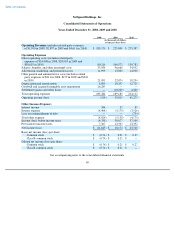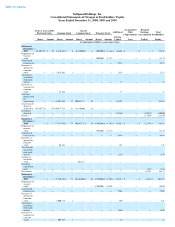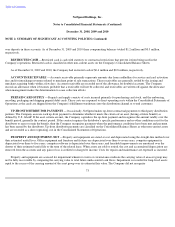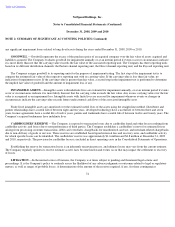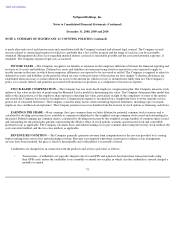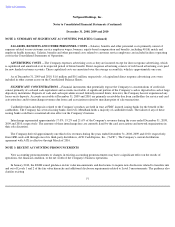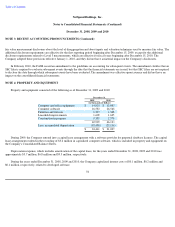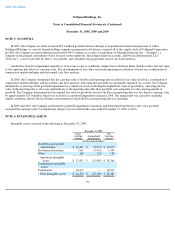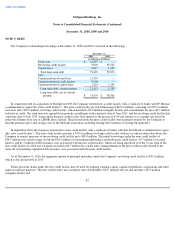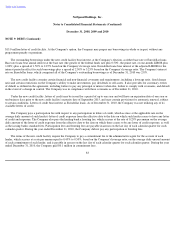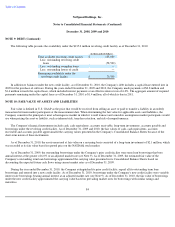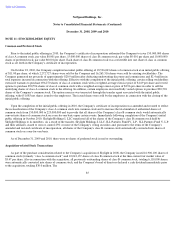NetSpend 2010 Annual Report Download - page 81
Download and view the complete annual report
Please find page 81 of the 2010 NetSpend annual report below. You can navigate through the pages in the report by either clicking on the pages listed below, or by using the keyword search tool below to find specific information within the annual report.
Table of Contents
NetSpend Holdings, Inc.
Notes to Consolidated Financial Statements (Continued)
December 31, 2008, 2009 and 2010
NOTE 2: SUMMARY OF SIGNIFICANT ACCOUNTING POLICIES (Continued)
is made after analysis of each known issue and consultation with the Company's internal and external legal counsel. The Company records
reserves related to certain legal matters for which it is probable that a loss will be incurred and the range of such loss can be reasonably
estimated. Management discloses facts regarding material matters assessed as reasonably possible and the associated potential exposure, if
estimable. The Company expenses legal costs as incurred.
INCOME TAXES —The Company recognizes tax benefits or expenses on the temporary differences between the financial reporting and
tax basis of its assets and liabilities. Deferred tax assets and liabilities are measured using statutory enacted tax rates expected to apply to
taxable income in the years in which those temporary differences are expected to be recovered or settled. The Company is required to adjust its
deferred tax assets and liabilities in the period in which tax rates or the provisions of the income tax laws change. Valuation allowances are
established when necessary to reduce deferred tax assets to the amount for which recovery is deemed more likely than not. The Company's
policy is to classify interest and penalties associated with uncertain tax positions as a component of income tax expense.
STOCK-BASED COMPENSATION —The Company has one stock-based employee compensation plan. The Company measures stock
options at fair value on the date of grant using the Binomial Lattice model for determining fair value. The Company determined this model best
reflects the characteristics of the employee share option in estimating fair value, particularly in light of the complexity of some of the options
and awards the Company has issued to its employees. Compensation expense is recognized on a straight-line basis over the requisite service
period, net of estimated forfeitures. The Company considers many factors when estimating expected forfeitures, including types of awards,
employee class and historical experience. The Company presents excess tax benefits from the exercise of stock options as financing cash flows.
EARNINGS PER SHARE —Basic earnings (loss) per common share excludes dilution for potential common stock issuances and is
calculated by dividing net income (loss) available to common stockholders by the weighted average common stock issued and outstanding for
the period. Diluted earnings per common share is calculated by dividing net income by the weighted average number of common shares issued
and outstanding for the period plus amounts representing the dilutive effect of stock options, warrants and restricted stock and convertible
preferred stock, as applicable. The Company calculates basic and diluted earnings (loss) per common share using the treasury stock method, the
as-if-converted method, and the two-class method, as applicable.
REVENUE RECOGNITION —The Company generally generates revenue from compensation for the services provided to its issuing
banks resulting from service fees and interchange revenue. Revenue is recognized when there is persuasive evidence of an arrangement,
services have been rendered, the price is fixed or determinable and collectability is reasonably assured.
Cardholders are charged fees in connection with the products and services provided, as follows:
• Transactions—Cardholders are typically charged a fee for each PIN and signature-based purchase transaction made using
their GPR cards, unless the cardholder is on a monthly or annual service plan, in which case the cardholder is instead charged a
monthly or annual
75





